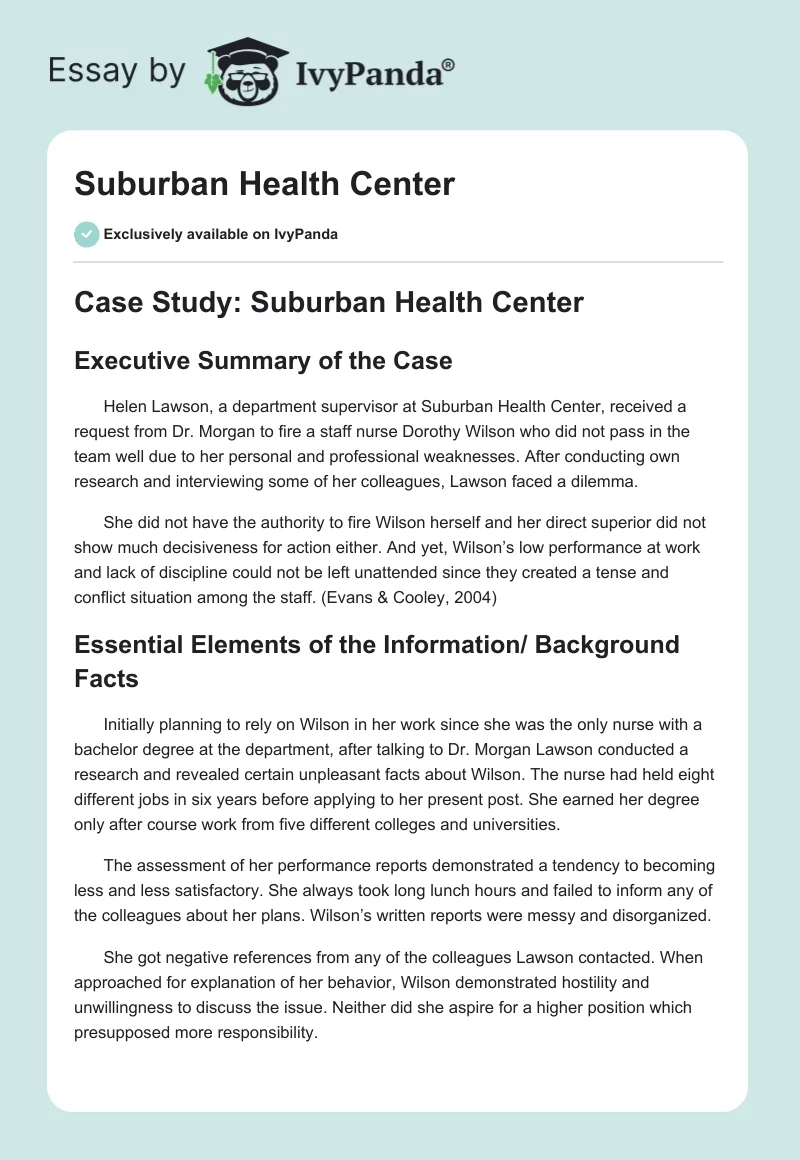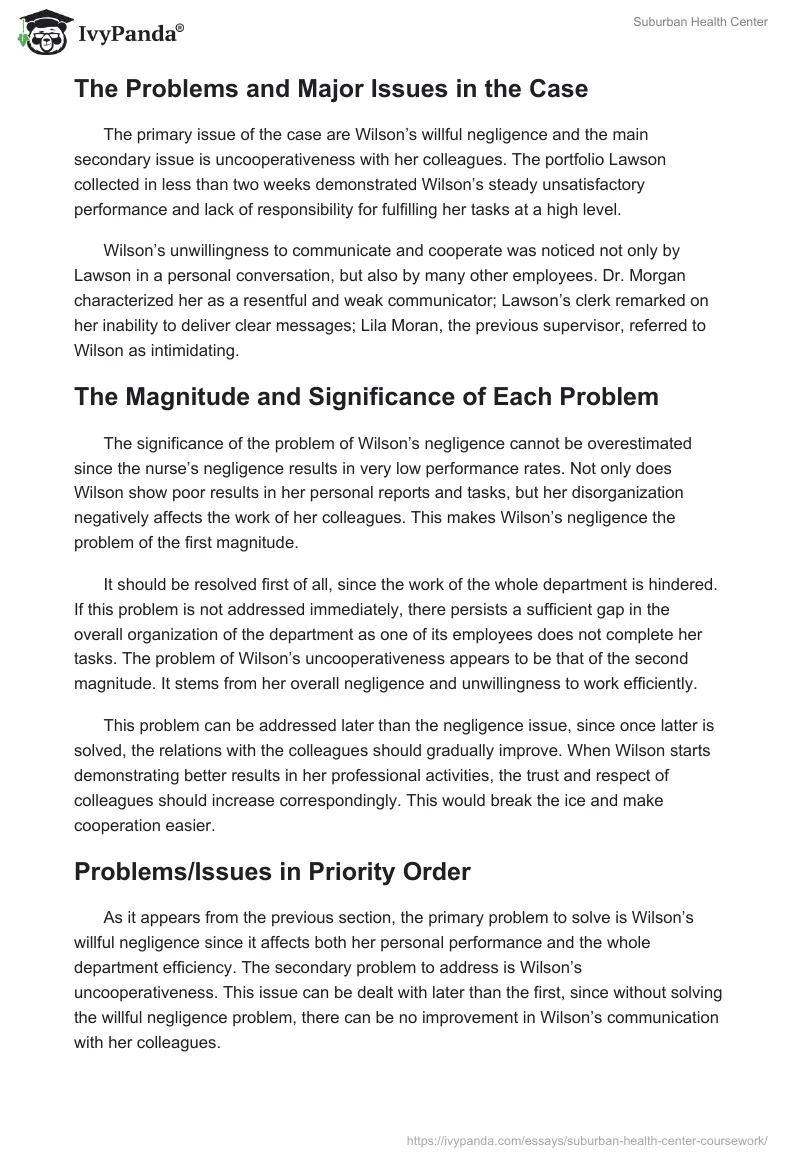Case Study: Suburban Health Center
Executive Summary of the Case
Helen Lawson, a department supervisor at Suburban Health Center, received a request from Dr. Morgan to fire a staff nurse Dorothy Wilson who did not pass in the team well due to her personal and professional weaknesses. After conducting own research and interviewing some of her colleagues, Lawson faced a dilemma.
She did not have the authority to fire Wilson herself and her direct superior did not show much decisiveness for action either. And yet, Wilson’s low performance at work and lack of discipline could not be left unattended since they created a tense and conflict situation among the staff. (Evans & Cooley, 2004)
Essential Elements of the Information/ Background Facts
Initially planning to rely on Wilson in her work since she was the only nurse with a bachelor degree at the department, after talking to Dr. Morgan Lawson conducted a research and revealed certain unpleasant facts about Wilson. The nurse had held eight different jobs in six years before applying to her present post. She earned her degree only after course work from five different colleges and universities.
The assessment of her performance reports demonstrated a tendency to becoming less and less satisfactory. She always took long lunch hours and failed to inform any of the colleagues about her plans. Wilson’s written reports were messy and disorganized.
She got negative references from any of the colleagues Lawson contacted. When approached for explanation of her behavior, Wilson demonstrated hostility and unwillingness to discuss the issue. Neither did she aspire for a higher position which presupposed more responsibility.
The Problems and Major Issues in the Case
The primary issue of the case are Wilson’s willful negligence and the main secondary issue is uncooperativeness with her colleagues. The portfolio Lawson collected in less than two weeks demonstrated Wilson’s steady unsatisfactory performance and lack of responsibility for fulfilling her tasks at a high level.
Wilson’s unwillingness to communicate and cooperate was noticed not only by Lawson in a personal conversation, but also by many other employees. Dr. Morgan characterized her as a resentful and weak communicator; Lawson’s clerk remarked on her inability to deliver clear messages; Lila Moran, the previous supervisor, referred to Wilson as intimidating.
The Magnitude and Significance of Each Problem
The significance of the problem of Wilson’s negligence cannot be overestimated since the nurse’s negligence results in very low performance rates. Not only does Wilson show poor results in her personal reports and tasks, but her disorganization negatively affects the work of her colleagues. This makes Wilson’s negligence the problem of the first magnitude.
It should be resolved first of all, since the work of the whole department is hindered. If this problem is not addressed immediately, there persists a sufficient gap in the overall organization of the department as one of its employees does not complete her tasks. The problem of Wilson’s uncooperativeness appears to be that of the second magnitude. It stems from her overall negligence and unwillingness to work efficiently.
This problem can be addressed later than the negligence issue, since once latter is solved, the relations with the colleagues should gradually improve. When Wilson starts demonstrating better results in her professional activities, the trust and respect of colleagues should increase correspondingly. This would break the ice and make cooperation easier.
Problems/Issues in Priority Order
As it appears from the previous section, the primary problem to solve is Wilson’s willful negligence since it affects both her personal performance and the whole department efficiency. The secondary problem to address is Wilson’s uncooperativeness. This issue can be dealt with later than the first, since without solving the willful negligence problem, there can be no improvement in Wilson’s communication with her colleagues.
Causal Factors and Alternative Courses of Action for the First Two Problems
The causes for the problem of willful negligence can be seen in Wilson’s unwillingness to understand and perform her duties and obligations as a nurse. As it is apparent from her refusal to get a promotion, Wilson possesses no career aspiration and therefore lacks motivation to show high results. Her poor performance was often overlooked by the previous supervisor, which increased her laxity.
In order to deal with the problem, it is proposed firstly to remind Wilson of all her duties and make her poor performance clear to her; secondly, to allot her with a trial period within which she should demonstrate improvement; thirdly, warn her of the negative consequences in case she fails. The perspective of losing her job should motivate Wilson for positive changes; otherwise, such an employee is useless for the department.
The cause for Wilson’s uncooperativeness lays firstly in her character traits, and secondly in the lack of motivation for cooperation. Once the first problem is addressed, the second should start to solve as well since communication and cooperation are part of Wilson’s duties. In order to further promote Wilson’s cooperation, additional arrangements can be made for team-building among the department staff.
The Positive and Negative Consequences of Implementing Each Proposed Alternative
The positive consequences for the proposed course of action to solve the first problem can be seen in the fact that Wilson is provided with an opportunity to demonstrate improvement. She will know exactly all the requirements and therefore it will be easier for her to measure up to them. The negative consequences for Wilson may be that she decides not to improve anything and simply resign.
But that may be a positive result for the department since it will be able to hire a more adequate employee. The positive consequences of implementing solutions to the second problem are seen in increasing cooperation and trust between Wilson and the department staff, and there are no negative consequences apparent (Useem, 1998).
Proposed Course of Action and a Brief Justification for the Recommendation
Wilson should be summoned for discussion of the situation and outlining the terms on which she may stay at the department (Harmon, & Lapenta, 2008). Close monitoring of her performance should be carried out, and Wilson should be aware that her work is controlled. Monitoring should be continued even if Wilson completes the trial period successfully, since she can demonstrate a tendency to relax.
Dr. Morgan should be informed of Wilson’s trial period and asked to demonstrate cooperation since it would be decisive for Wilson’s improvement or dismissal. This course of action would allow for checking Wilson for the willingness to work at the department and taking a final decision based on definite results of the trial period.
The Major Difficulties Anticipated if the Recommendation is Implemented
The two major difficulties one can face when implementing the recommendations are Wilson’s uncooperativeness and the sceptic attitude of the staff to the experiment. Wilson’s negligence has been overlooked by the supervisors for too long for the staff to believe that anything can be improved.
The Major Criteria/Standards to Monitor the Performance of the Recommended Course of Action
When Wilson goes through her trial period, it is important to make a graphic scale according to which each of the task she performs is accessed. The scale should include such criteria as self-discipline, maintaining work discipline, meeting the deadlines, producing well-organized reports, informing colleagues of the necessary absence, etc. The results of monitoring should be open to Wilson as a way of motivating her to self-improvement.
References
Evans, B. D., & Cooley, G. S. (2004). Suburban Health Center. In J. S. Rakich, B. B. Longest & K.Darr (Eds.), Cases in health services management, 4th ed. (pp. 357–360). Baltimore, MD: Health Professions Press.
Harmon, L., Lapenta, S. (2008). Managing difficult and disruptive physicians. In K. H. Cohn & D. E. Hough (Eds.), The business of healthcare: Volume 1, Practice management (pp. 75–92). Westport, CT: Praeger Publishers.
Useem, M. (1998). The leadership moment: Nine true stories of triumph and disaster and their lessons for us all. New York, NY: Three Rivers Press.


